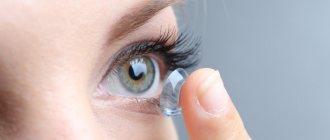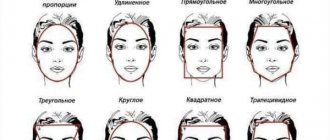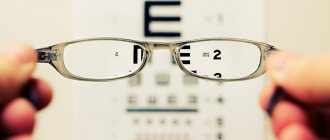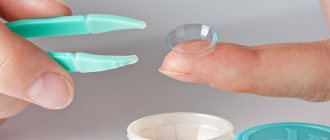The modern contact lens market offers children and adults with visual impairments a wide selection of products and accessories that facilitate the process of using corrective products. What was sold 10-15 years ago is not at all similar to new developments. Modern lenses are easy to put on and take off without risk to health.
Before removing lenses from your eyes for the first time, you need to remember the rules for sanitizing your hands and accessories, as well as familiarize yourself with existing techniques.
Preparation
Today there are 3 types of optical lenses.
These include:
- soft made of silicone and hydrogel - are products from the corneoscleral group that are put on the cornea and partially touch the sclera;
- hard - designed for the cornea, worn exclusively on the cornea;
- scleral - made of polymacone, when worn, they capture the entire eye white and cornea.
Depending on the type of optical lenses, the method of removing them, the choice of method and the duration of the process as a whole differs.
What's useful
Before you begin the process of removing contact lenses, you need to have the following necessary items on hand:
- soap;
- dry disposable wipes;
- box for lenses;
- tweezers with a silicone tip;
- special cleaning agent for optics;
- mirror.
You also need to consider general rules that will help you remove lenses easily and without problems:
- It is most convenient to do the procedure while sitting, with your elbow resting on a hard surface;
- You can make removal easier by using a mirror;
- It is imperative that the room has good lighting, but not glare.
You should always remember that you need to start removing optical lenses in the same way as you put them on - from the same eye. In the same way, you need to put the lenses in the compartments of the storage container. This is due to the fact that in appearance the left and right lenses are no different, but the relief of the cornea has differences at the micro level. Therefore, incorrect wearing of optical lenses can cause a decrease in their corrective properties.
Removing lenses
There are general rules that help you remove lenses without much difficulty.
You can easily remove the optics by following these instructions:
- The first step is to remove your hair from your face.
- Next, wash your hands well using soap. Any moisture remaining on your hands should be blotted with a dry cloth.
- The container for storing lenses is prepared in advance. The container should be placed close to you and a special solution should be poured into the container.
- Using the index finger and thumb on one hand, you need to open your eyelids.
- Next, use the index finger and thumb of your other hand to grab the edges of the lens and pull it down. When performing such actions, the gaze should be directed upward.
- If the action is carried out correctly, the optics will go beyond the edge of the eye; the presence of long nails makes it necessary to use special tweezers with a soft tip.
- The removed lens can be placed in a container. As a rule, the cells of such containers are designated “R” - for the right lens, “L” - for the left lens.
- Each step must be repeated to remove the lens from the other eye.
Types of contact lenses
Instructions on how to properly put on lenses do not depend on their type. The main classification is based on the refractive error they are intended to correct. There are models that help restore clarity of vision with:
- Myopia. The greater the distance between the object and the eyes, the more it “blurs.” Spherical contact lenses are used for correction.
- Presbyopia. This is “age-related farsightedness.” The symptoms are the same as for hypermetropia. To restore vision, you need multifocal lenses.
- Hyperopia. What is nearby appears blurry to a person. For example, difficulties arise with reading. Spherical contact lenses are also required.
- Keratoconus. A pathology in which the cornea becomes thinner, simultaneously changing its shape from spherical to cone-shaped. For correction, scleral lenses are worn, which differ from ordinary ones in their larger diameter.
- Astigmatism. Clarity of vision suffers due to changes in the shape of the lens. For correction, toric lenses are worn.
Color contact lenses
Sometimes contact lenses are worn by people who do not need vision correction. “Image” models are represented by several groups:
- Tinted. They are worn to highlight the natural color of the eyes and make it more saturated. The look becomes more expressive and impressive.
- Colored. They differ from tints by using a brighter pigment. They give an unnatural color, such as emerald.
- "Creative" or "fantasy". They allow you to change the shape of the pupil from round to elongated (“cat” or “snake”), get a color of the iris that is not found in nature, or turn the eye into an “art object” (billiard ball, soccer ball).
Tint and color models are available with and without diopters.
Tinted varieties are not included in the “colored” category. They appear transparent to the eyes. Manufacturers give them a pale greenish or bluish tint for ease of handling.
The dye is not applied to the outer surface of the lens, so it cannot come into contact with the cornea. The central part covering the pupil is never painted. Therefore, wearing such correction means does not affect the sharpness, clarity of vision, or color perception.
Colored contact lenses are also used for medical reasons. They are worn for various iris defects, congenital or acquired. These include:
- heterochromia (different eye colors or “spots” of a different shade on the iris);
- coloboma (“splitting” of the iris into separate “fragments”);
- leukoma (cloudness, “sore” on the eye);
- albinism (almost colorless pale gray or watery blue, pinkish or reddish iris).
Ophthalmologists also recommend them for people with increased photosensitivity (they play the role of sunglasses, protecting the eyes from ultraviolet rays).
Classification by period of wearing
Another important parameter is the wearing period. The nuances of care depend on this. Models are:
- Disposable. They are put on in the morning and taken off in the evening and thrown away immediately. You can't sleep in them.
- Flexible wearing mode. They are worn without taking them off for 2-3 days. Less often, the wearing period is 5-6 days.
- Planned replacement. They need to be put on and taken off daily and are not intended for sleeping. The service life of one pair is from 1-2 weeks to six months (rarely up to a year).
- Long wearing. Do not remove for 2 weeks, a month or 3 months.
- Orthokeratological. Worn only while sleeping, they are intended to correct vision at night. During the day, thanks to them, a person does without corrective glasses.
It is more convenient to purchase disposable correction products in whole packages.
Classification by material of manufacture
The material from which contact optics are made can cause allergies. Therefore, manufacturers use several varieties of it. Lenses are:
- Tough. They are divided into gas-permeable and gas-tight. The material used is silicone based. They do not deform even when worn for a long time, do not move when blinking, and the surface does not scratch.
- Soft. There are hydrogel ones (they have a short period of use, but at the same time they are very thin, smooth, and maximally saturated with moisture), and silicone hydrogel ones (they combine strength and resistance to mechanical damage with good oxygen permeability, providing the cornea with the necessary hydration).
There are no models designed specifically for beginners that would be easier to take on and off.
How to remove hard lenses
There are several ways to remove hard lenses.
The first option is to let the optics fall out of your eyes on their own. To do this, you need to tilt your head over a sterile container or surface. With your index fingers you need to press simultaneously on the middle of the upper and lower eyelids.
Next, you should carefully squeeze your eyelids, directing them towards each other. Thus, air will appear between the optical lens and the eye, which will interfere with adhesion, which means that the accessory will fall out on its own.
The second option is to bend over and use the index finger of one hand to pull the outer corner of the eye as if towards the ear. The more the eyelids touch each other, the faster the contact lens will come off the eyeball.
The third option is to sit comfortably and level your head. Now you need to roll your eyes up. Using your index finger, you need to pull the product into the sclera area. Now you can pry up the lens using your thumb and index finger and carefully remove it.
Why is it important to maintain hygiene and rules for using lenses?
Violation of simple doctor’s recommendations and instructions for removing/putting on eyepieces can lead to serious complications:
- Penetration of infection into the visual apparatus;
- Irritation due to microparticles of dust or cosmetics getting on the mucous membrane;
- Injury to the cornea;
- Violation of the integrity of the optical product.
| When the first unpleasant symptoms appear (photophobia, redness, itching, increased lacrimation, etc.), contact the clinic immediately. |
How to remove scleral lenses
To remove scleral lenses, you must also follow the rules. To quickly remove the accessory, you need to use the index finger of either hand to pull and fix the lower eyelid as low as possible.
This makes the edge of the lens visible, which you should grab with your thumb and forefinger and carefully pull it down. There is no need to change the position of the lenses; its movement should be easy. Thus, she herself will go beyond the boundaries of the eyeball. It must be remembered that, regardless of the type of optical lenses, the first stages of removal should be preparatory measures and mandatory compliance with hygiene rules.
Detailed step-by-step installation instructions
- Hand washing.
- This step is mandatory, since the eyepiece is in direct contact with the eye, and dirty hands can cause infections. In this case, you need to wipe your hands dry and make sure that there is no lint left on them from the towel. If even a small piece of lint gets into your eye, it will hurt!
- Removing lenses from the container. It usually has two compartments: for the right (R) and left eyepiece (L). Although
Some manufacturers simply highlight the right cover in a different color. It’s better to start with the right one: carefully use tweezers or two fingers of your right hand to take the lens and place it on the tip of your index finger. We check that it is not inside out (correctly - edges up, incorrectly - downwards) and that there are no fluffs, dust particles or other small debris on it.
- Installation in the eyes. It is advisable to get used to dressing yourself
contact lenses (CL) from the right eye. Use your index finger to pull the lower eyelid down, and with your middle finger slightly lift the upper eyelid. At this time, it is better to look not at the lens, but somewhere to the side, so that the subconscious does not tune in to closing the eye when it approaches. At the same time, you can wear it anywhere, as long as it is visible to the eye. After this, you need to close it and stroke the eyelid a little with your fingertips - the CL will straighten and fall into place.
To make it clearer, we recommend watching the video: “How to properly put on lenses (contact)”:
Contact lenses can be put on with one hand or two. It is advisable to do this while sitting at a table and looking in the mirror. Each eye should have its own lens; it is not recommended to confuse them. The solution must be changed daily!
What to do if the lens is stuck
At first, beginners often encounter situations where the lens cannot be removed because it is stuck to the shell of the eye. This can happen for several reasons:
- Incorrect placement of the contact lens, most often the product in such cases moves to the inner corner of the eyes.
- Drying of the mucous membrane of the eye, constant feeling of dryness. In this case, it is recommended to use special moisturizing drops.
Knowing about the possible reasons, it will not be superfluous to understand how to act in such situations. First you need to determine exactly where the lens is located. If it is centrally located, it can be removed using a special suction cup device designed for such cases. The second step is hydration.
This step can be done in several ways:
- just blink several times without interruption, activating the flow of tears;
- drip a few drops of special moisturizing preparations into the conjunctival sacs.
You can also remove contact lenses while doing a massage. To do this, close your eyelids and lightly massage your eyeballs. This will help move the lenses so they can be easily removed.
We recommend reading: The lens does not stick to the eye
Taking care of your lenses
Proper care is mandatory during operation. Improper care can result in serious vision problems. It is important to follow the instructions and advice of specialists and not violate them.
The main thing is to follow the rules of care. In daily care, there are mandatory simple actions: cleaning, rinsing, disinfection. Remember - you should put them on and take them off with extreme care, they are very fragile.
Cleaning will not be completed if you use tap water. It is best to use special solutions that guarantee one hundred percent cleansing of contaminants.
Wash your hands and dry them with a lint-free towel.
Fill the container with disinfectant solution.
To avoid confusion, always put on and take off in the same order.
Do the cleansing procedures immediately: remove it, place it on the palm of your hand, and drop a drop of solution on top. Apply the special solution carefully to the outer and inner surfaces. Wipe carefully, do not damage, do not press. Place the cleaned lens in the clean compartment of the container.
Carry out a similar operation with the other one.
Close the container. Store its contents in this form until the morning.
It is not recommended to use a disinfectant solution twice, as this will reduce the antibacterial properties, which is a huge health problem.
The container has its own terms of safe use.
Compliance with the rules of care will ensure the safety of the visual organs. There is the slightest suspicion: the expiration date has expired, mechanical damage has occurred - the lenses should be replaced. This will avoid unpleasant surprises.
What to do if you can’t remove the lens
There are times when it is not possible to remove a contact lens due to improper care or violation of the rules for their use. Wearing optical products longer than the maximum permitted period for use without interruption.
In this case, the natural hydration of the mucous membrane is significantly reduced. Also, when worn for a long time, the lenses become covered with protein and fat from tears, which over time acquire the properties of cement. In this case, the lens is fixed in one place and is very difficult to remove.
In this case, to remove soft lenses you need to:
- Understand where exactly the optics are located, use all methods to the maximum to return it to its place.
- You also need to moisturize your eye. You can massage your eyelid.
- When returning the product to its place, you can pull it out with a suction cup.
To remove hard lenses:
- In the same way, you need to understand where they are.
- If necessary, return the accessory to its proper place. To do this, you can perform circular massage movements towards the center.
- Remove lenses using specialized tools.
It is forbidden to move the lenses with your fingers or use improvised means for this. This can not only ruin optical products, but also damage the mucous membrane. If none of the methods helps to remove contact lenses, you should consult a doctor. If there is redness, pain, itching, uncharacteristic discharge and other signs of pathological disorders, you should urgently visit an ophthalmologist.
Expert advice
Before the lens removal procedure, you should always moisturize your eyes with a solution. After this, dry your fingers and remove the lens. Before instillation, be sure to read the instructions that come with the package.
If you experience even the slightest feeling of discomfort in your eyes before going to bed, do not go to bed, as the next morning they will be completely dry, which can lead to infection. If the cornea remains red and irritated even after removing ophthalmic products, we strongly recommend that you consult a qualified ophthalmologist. Most likely, you accidentally scratched your eyeballs.
Take care of your eyes!
Special suction cup for removing lenses
Specially designed tools for putting on and removing contact lenses are quite popular among beginners. Many of them use tweezers and suction cups to avoid problems until they learn to quickly put on and remove lenses on their own. Such a device is a specially designed tool that helps to quickly remove the lens, since it has a special suction cup tip.
Users consider the following advantages of such a device:
- Convenient removal of the film, since it is located on a suction cup and does not move along the membrane of the eye and is quickly removed;
- Safety of the process - there is no need to pull the eyelids and run your fingers over the mucous membrane of the eyes;
- Careful execution - with such removal, the product does not spoil its shape and does not lose properties;
- Accurate hit - thanks to the tip, the lens is quickly fixed and removed.
Before using any instruments, they must be sterilized with special means. Using such methods, you can easily and accurately remove optical lenses, the main thing is to gain experience and practice regularly.
Features of wearing eye lenses
Contact lenses are not as easy to use as compared to glasses. These glasses require only two efforts - put them on and take them off. With lenses everything is different. It should be remembered that they come into direct contact with the eyeball, their use requires strict adherence to wearing rules.
- Wash your hands thoroughly with soap before putting on and taking off.
- Use only special cleaning solutions. Do not use tap water.
- Use lens solution only during its shelf life. Do not use the solution twice.
- Observe wearing times.
- Do not use during colds.
- Put on before applying makeup, remove before removing makeup.
It is considered a violation of all hygiene rules to give your lenses to other people; this can lead to the development of allergic reactions.
It is not recommended to visit the sauna, swim in the pool, wash your hair, or take a shower without first removing your lenses. It is not recommended to engage in active sports while wearing lenses.
The whites may turn red due to eye fatigue during the day. This is a normal phenomenon; after removing the optics, your eyes will rest, everything will be fine. Special eye moisturizing drops will help relieve the discomfort. Irritation and redness of the eyes do not go away, pain occurs, vision deteriorates, you need to consult a specialist.
It is very important to gradually accustom your eyes to lenses. At first, wear it for several hours a day, increasing the wearing time by an hour. During the first days, use special drops so that the adjustment time passes unnoticed and quickly.
You can’t sleep in your lenses and don’t take them off for several days. It is necessary to strictly observe the wearing regime.
If you follow simple rules for wearing lenses, you can greatly facilitate the process of getting used to it, putting it on, taking it off, which will make them safe.
An ophthalmologist will tell you more detailed information about this vision correction.
Particular attention should be paid to color contact optics. Their wearing time is slightly different from other types. Wear colored lenses for no more than five hours, remove immediately if pain, redness, or tingling occurs. Violation of the rules of wearing leads to deterioration of vision.
Features of removal technology
It is necessary to apply eye drops to help moisturize the eye. Take the suction cup in your hand and slightly pull your eyelids. Bring it perpendicular to the eye. Squeeze the air gun and press it against the cornea. Then gently release the gun, the suction cup will stick due to the pressure decrease. Then you need to pull it away from you along with the lens.
It is worth noting that the suction cup has a minus. It should be the optimal size for the lens.
The diameters do not always match. The suction cup has a larger one, and you have to open your eyes wide. However, using a suction cup is much safer and faster than using your hands.
Recommendations from experienced users
Sometimes even step-by-step instructions and videos can be useless.
It seems that while you read and watch, everything seems so easy and understandable. And as soon as you start putting on the CL, nothing happens.
Therefore, we recommend that you familiarize yourself with the recommendations of experienced lens wearers, who also encountered the fact that they had to spend more than two hours getting dressed:
- Calm. It is advisable to put on a contact lens when there is no one nearby, or when no one is in the way. The mood should be good or normal. Otherwise, the lack of results can further aggravate the situation and cause a wave of irritation.
- CCTV. In order to understand what the error is that makes it impossible to put the lens on correctly, you can record a video on a video camera or a regular phone. After all, advice from friends and step-by-step instructions may be incomprehensible. For example, I seem to do everything as in the video, but the CL still turns out or the eye automatically closes.
- Eye contact. Let us repeat, it is not necessary to aim directly at the cornea; let the lens actually hit the eye. And there, through the closed eyelid, you can straighten it and it will fall into place correctly.
- Lie down. After installation, you can lie down a little with your eyes closed, face down. After this, open your eyes, move them in different directions, blink to check the absence of discomfort.










